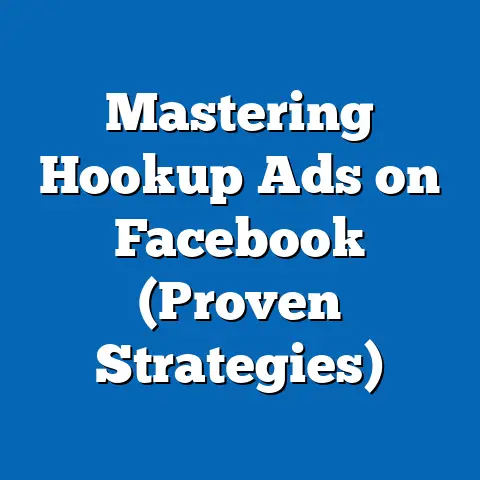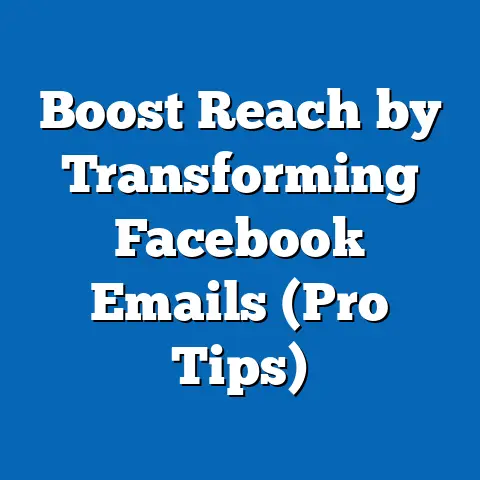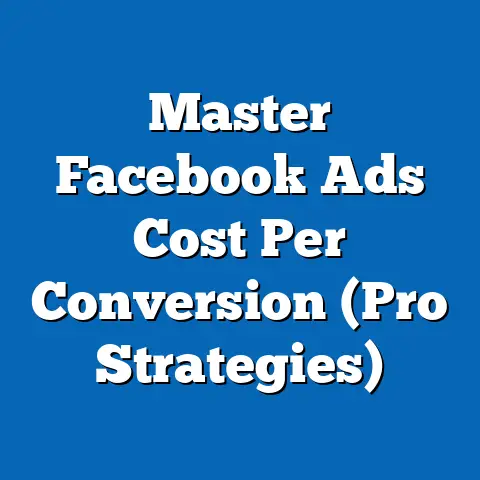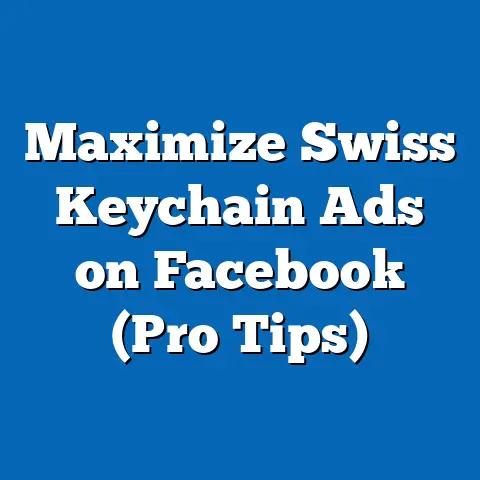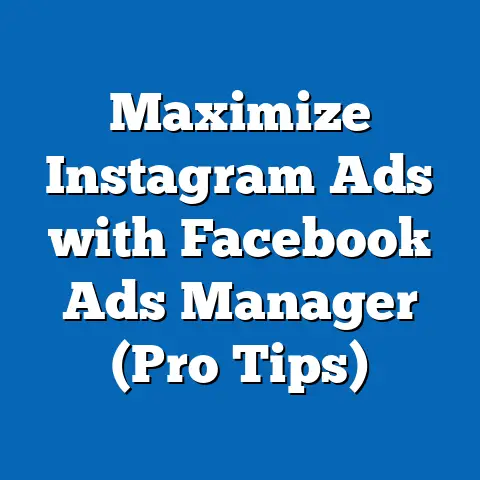Optimal Facebook Ad Length Unveiled (Proven Strategies)
I remember the first time I tried running a Facebook ad for my aunt’s dog grooming business. I was so excited! I poured all my creativity into crafting what I thought was the perfect ad – a long, heartfelt story about her passion for pups, complete with adorable photos. I hit “publish” with a flourish, convinced it would go viral.
Crickets.
The ad barely got any engagement. It was a humbling experience, and it forced me to confront a crucial truth about Facebook advertising: length matters.
In today’s fast-paced digital world, where attention spans are shorter than ever, the length of your Facebook ad can make or break its success. This is especially true for pet businesses, where you’re competing for the attention of pet owners who are constantly bombarded with adorable animal content. They’re scrolling through pictures of cats in sweaters and dogs doing tricks! How do you cut through the noise?
Facebook ads are a powerful tool for pet businesses. They allow you to target specific demographics, interests, and behaviors, reaching potential customers who are actively looking for products and services for their furry, feathered, or scaled companions. According to Statista, Facebook is the most used social media platform by marketers worldwide. This means it’s a great place to reach a large audience. But with great power comes great responsibility – the responsibility to craft ads that are not only visually appealing but also concise and impactful.
By the end of this article, you’ll have a clear understanding of how to leverage ad length to maximize engagement, drive conversions, and ultimately grow your pet business on Facebook. Let’s unleash the power of effective ad length!
Section 1: Understanding Facebook Ad Formats
Facebook offers a diverse range of ad formats, each with its own optimal length and engagement potential. Understanding these formats is the first step towards crafting effective ads that capture the attention of pet owners.
Here’s a breakdown of the most common Facebook ad formats and their typical lengths:
-
Image Ads: These are the simplest form of Facebook ads, featuring a single image and accompanying text.
- Typical Length: Headline (25 characters), Primary Text (125 characters), Description (30 characters).
- My Take: Image ads are great for showcasing a specific product or service, like a new line of dog toys or a special offer on cat food. The key is to use a high-quality, eye-catching image and a concise, compelling headline.
-
Video Ads: Video ads are dynamic and engaging, allowing you to tell a story or demonstrate your product in action.
-
Typical Length: 15 seconds or less is ideal for capturing attention in the newsfeed. Shorter videos often perform better. However, longer videos (up to a few minutes) can be effective for more in-depth storytelling.
- My Experience: I’ve found that short, snappy videos showcasing adorable pets using a product tend to perform exceptionally well. People love watching cute animals!
-
Carousel Ads: Carousel ads feature multiple images or videos that users can swipe through, allowing you to showcase a variety of products or highlight different aspects of your business.
-
Typical Length: Headline (40 characters per card), Description (20 characters per card).
- Pro Tip: Carousel ads are perfect for pet stores with a wide range of products or for showcasing different services offered by a veterinary clinic.
-
Slideshow Ads: Slideshow ads are similar to video ads but use a series of static images instead of a video. They’re a great option if you don’t have the resources to create a full-fledged video.
-
Typical Length: Similar to image ads, with short headlines and descriptions for each slide.
- My Insight: Slideshow ads can be surprisingly effective, especially if you use high-quality images and tell a compelling story.
-
Collection Ads: Collection ads are designed for e-commerce businesses and feature a main image or video with a selection of related products displayed below.
-
Typical Length: Headline (25 characters), Primary Text (125 characters).
- Best Use: Ideal for pet supply stores looking to showcase their best-selling products or promote a specific collection.
Image Ads: These are the simplest form of Facebook ads, featuring a single image and accompanying text.
- Typical Length: Headline (25 characters), Primary Text (125 characters), Description (30 characters).
- My Take: Image ads are great for showcasing a specific product or service, like a new line of dog toys or a special offer on cat food. The key is to use a high-quality, eye-catching image and a concise, compelling headline.
-
Video Ads: Video ads are dynamic and engaging, allowing you to tell a story or demonstrate your product in action.
-
Typical Length: 15 seconds or less is ideal for capturing attention in the newsfeed. Shorter videos often perform better. However, longer videos (up to a few minutes) can be effective for more in-depth storytelling.
- My Experience: I’ve found that short, snappy videos showcasing adorable pets using a product tend to perform exceptionally well. People love watching cute animals!
-
Carousel Ads: Carousel ads feature multiple images or videos that users can swipe through, allowing you to showcase a variety of products or highlight different aspects of your business.
-
Typical Length: Headline (40 characters per card), Description (20 characters per card).
- Pro Tip: Carousel ads are perfect for pet stores with a wide range of products or for showcasing different services offered by a veterinary clinic.
-
Slideshow Ads: Slideshow ads are similar to video ads but use a series of static images instead of a video. They’re a great option if you don’t have the resources to create a full-fledged video.
-
Typical Length: Similar to image ads, with short headlines and descriptions for each slide.
- My Insight: Slideshow ads can be surprisingly effective, especially if you use high-quality images and tell a compelling story.
-
Collection Ads: Collection ads are designed for e-commerce businesses and feature a main image or video with a selection of related products displayed below.
-
Typical Length: Headline (25 characters), Primary Text (125 characters).
- Best Use: Ideal for pet supply stores looking to showcase their best-selling products or promote a specific collection.
Video Ads: Video ads are dynamic and engaging, allowing you to tell a story or demonstrate your product in action.
Typical Length: 15 seconds or less is ideal for capturing attention in the newsfeed. Shorter videos often perform better. However, longer videos (up to a few minutes) can be effective for more in-depth storytelling.
Carousel Ads: Carousel ads feature multiple images or videos that users can swipe through, allowing you to showcase a variety of products or highlight different aspects of your business.
Typical Length: Headline (40 characters per card), Description (20 characters per card).
Slideshow Ads: Slideshow ads are similar to video ads but use a series of static images instead of a video. They’re a great option if you don’t have the resources to create a full-fledged video.
Typical Length: Similar to image ads, with short headlines and descriptions for each slide.
Collection Ads: Collection ads are designed for e-commerce businesses and feature a main image or video with a selection of related products displayed below.
Typical Length: Headline (25 characters), Primary Text (125 characters).
Engagement Rates and Performance Metrics
Each ad format has its own unique strengths and weaknesses, and engagement rates can vary depending on the target audience and the quality of the creative.
According to a recent study by HubSpot, video ads tend to have higher engagement rates than image ads, with an average click-through rate (CTR) of 1.84% compared to 0.98% for image ads. However, video ads also require more investment in terms of production costs and time.
Carousel ads can also be highly effective, especially for showcasing multiple products. They allow users to explore different options and find the perfect fit for their needs.
Selecting the Right Format
The key to success is to choose the ad format that best aligns with your campaign objectives and target audience.
- Brand Awareness: Video ads and slideshow ads are great for building brand awareness and telling your brand story.
- Product Promotion: Image ads and carousel ads are ideal for showcasing specific products and driving sales.
- Lead Generation: Lead generation ads allow you to collect contact information from potential customers directly on Facebook.
- Website Traffic: Ads that drive traffic to your website can use any of the above formats, but make sure your landing page is optimized for conversions.
Takeaway: Understanding the different Facebook ad formats and their typical lengths is crucial for creating effective campaigns. Choose the format that best aligns with your campaign objectives and target audience.
Section 2: The Psychology of Attention in Pet Advertising
In the digital age, our attention spans are constantly being bombarded with information. Understanding the psychology of attention is paramount for creating Facebook ads that cut through the noise and resonate with pet owners.
Attention Span on Social Media
Studies have shown that the average attention span is shrinking, particularly on social media platforms like Facebook. According to Microsoft, the average human attention span has fallen to just eight seconds – shorter than that of a goldfish!
This means you have a very limited window to grab the attention of potential customers and convince them to engage with your ad.
Pet Owners and Content Engagement
Pet owners are a highly engaged audience on social media. They love sharing photos and videos of their pets, connecting with other pet owners, and discovering new products and services for their furry friends.
However, they are also bombarded with pet-related content every day. To stand out, your ads need to be visually appealing, emotionally resonant, and highly relevant to their interests.
Emotional Resonance
Emotional resonance is the key to capturing attention and driving engagement. Pet owners are passionate about their animals, and they respond strongly to ads that tap into their emotions.
- Happiness: Showcasing adorable pets playing with your products or enjoying your services can evoke feelings of happiness and joy.
- Love: Emphasizing the bond between pet owners and their animals can create a strong emotional connection.
- Relief: Highlighting how your products or services can solve common pet-related problems can provide a sense of relief and reassurance.
- Nostalgia: Using images or videos that evoke memories of beloved pets can create a powerful emotional connection.
Attention-Grabbing Techniques
Here are some specific techniques you can use to grab the attention of pet owners on Facebook:
- Use High-Quality Visuals: Eye-catching images and videos are essential for capturing attention. Use professional-quality photos or videos that showcase your products or services in the best possible light.
- Tell a Story: Storytelling is a powerful way to connect with your audience on an emotional level. Share stories about happy customers, rescued animals, or the unique bond between pets and their owners.
- Use Humor: Humor can be a great way to grab attention and make your ad more memorable. Just make sure your humor is appropriate for your target audience and doesn’t offend anyone.
- Ask a Question: Asking a question can pique curiosity and encourage people to click on your ad.
- Use a Call to Action: A clear call to action tells people what you want them to do, whether it’s visiting your website, signing up for your newsletter, or making a purchase.
Takeaway: Understanding the psychology of attention is crucial for creating Facebook ads that resonate with pet owners. Focus on emotional resonance, use attention-grabbing techniques, and make sure your ads are highly relevant to their interests.
Section 3: Proven Strategies for Ad Length
Now that we understand the psychology of attention, let’s dive into the specifics of ad length. What is the optimal length for a Facebook ad targeting pet owners?
The answer, as with most things in marketing, is: it depends.
There’s no one-size-fits-all answer to the question of optimal ad length. The ideal length will vary depending on your ad format, campaign objectives, target audience, and the specific message you’re trying to convey.
However, I can share some proven strategies and general guidelines based on industry research and my own experience.
Short-Form Ads (Under 15 Seconds or 90 Characters)
- Benefits: Short-form ads are great for capturing attention quickly and conveying a simple message. They’re ideal for mobile users who are scrolling through their newsfeeds on the go.
- Drawbacks: Short-form ads may not be sufficient for conveying complex information or telling a detailed story.
- Best Use Cases:
- Promoting a limited-time offer or discount.
- Driving traffic to your website with a clear call to action.
- Building brand awareness with a visually appealing image or video.
- Examples:
- “50% OFF Dog Toys This Weekend Only! Shop Now!” (Text ad)
- A 10-second video showcasing a cute puppy playing with a new toy.
- Expert Insight: According to Neil Patel, “Shorter ads are generally more effective for driving immediate action, such as clicks or purchases.”
- Promoting a limited-time offer or discount.
- Driving traffic to your website with a clear call to action.
- Building brand awareness with a visually appealing image or video.
- “50% OFF Dog Toys This Weekend Only! Shop Now!” (Text ad)
- A 10-second video showcasing a cute puppy playing with a new toy.
Medium-Length Ads (15-30 Seconds or 90-150 Characters)
- Benefits: Medium-length ads allow you to provide more information and tell a more compelling story. They’re ideal for engaging users who are already interested in your brand or product.
- Drawbacks: Medium-length ads may lose the attention of users who are not immediately engaged.
- Best Use Cases:
- Explaining the benefits of your product or service in more detail.
- Sharing a customer testimonial or success story.
- Highlighting the unique features of your business.
- Examples:
- “Our All-Natural Dog Food is Made with High-Quality Ingredients and Supports a Healthy Coat and Digestion. Learn More!” (Text ad)
- A 20-second video featuring a veterinarian discussing the importance of dental care for pets.
- Real-World Example: A local pet store ran a Facebook ad with a 25-second video showcasing their new line of organic cat treats. The ad highlighted the health benefits of the treats and featured several cats happily munching away. The ad resulted in a 30% increase in sales of the cat treats.
- Explaining the benefits of your product or service in more detail.
- Sharing a customer testimonial or success story.
- Highlighting the unique features of your business.
- “Our All-Natural Dog Food is Made with High-Quality Ingredients and Supports a Healthy Coat and Digestion. Learn More!” (Text ad)
- A 20-second video featuring a veterinarian discussing the importance of dental care for pets.
Long-Form Ads (Over 30 Seconds or 150+ Characters)
- Benefits: Long-form ads allow you to tell a detailed story, build a strong emotional connection with your audience, and provide in-depth information about your brand or product.
- Drawbacks: Long-form ads require a significant investment in terms of time and resources, and they may lose the attention of users who are not highly engaged.
- Best Use Cases:
- Sharing a heartwarming story about a rescued animal.
- Providing a detailed explanation of your company’s mission and values.
- Showcasing the expertise of your staff.
- Examples:
- A 60-second video telling the story of a dog who was rescued from a shelter and found a loving home thanks to a local pet adoption agency.
- A blog post about the importance of pet insurance, shared as a Facebook ad.
- Caution: Long-form ads should only be used if you have a compelling story to tell and a highly engaged audience.
- Sharing a heartwarming story about a rescued animal.
- Providing a detailed explanation of your company’s mission and values.
- Showcasing the expertise of your staff.
- A 60-second video telling the story of a dog who was rescued from a shelter and found a loving home thanks to a local pet adoption agency.
- A blog post about the importance of pet insurance, shared as a Facebook ad.
Insights from Successful Pet Brands
Many successful pet brands have leveraged varying ad lengths effectively.
- Chewy: Chewy often uses short, visually appealing video ads to showcase their wide range of products.
- Petco: Petco uses a mix of short and medium-length ads to promote their products and services, as well as share helpful tips and advice for pet owners.
- Blue Buffalo: Blue Buffalo often uses long-form ads to educate consumers about the benefits of their natural pet food.
Takeaway: Experiment with different ad lengths to see what resonates best with your target audience. Consider your ad format, campaign objectives, and the specific message you’re trying to convey. Remember, the key is to grab attention, engage your audience, and drive results.
Section 4: Crafting the Perfect Message
Ad length is only one piece of the puzzle. The messaging within your ad is just as important, if not more so. The right message, delivered effectively, can make even a short ad incredibly impactful.
Clarity and Emotional Appeal
The most effective Facebook ads for pet businesses combine clarity with emotional appeal. Your message should be easy to understand and highly relevant to the interests of pet owners. It should also tap into their emotions, whether it’s happiness, love, relief, or nostalgia.
Compelling Headlines and Calls-to-Action
Your headline is the first thing people will see, so it needs to be attention-grabbing and compelling. Your call-to-action tells people what you want them to do, so it needs to be clear and concise.
- Headlines:
- Use strong verbs and action words.
- Highlight the benefits of your product or service.
- Ask a question that piques curiosity.
- Use numbers or statistics to add credibility.
- Calls-to-Action:
- Use clear and concise language.
- Tell people exactly what you want them to do.
- Create a sense of urgency.
- Make it easy for people to take action.
- Use strong verbs and action words.
- Highlight the benefits of your product or service.
- Ask a question that piques curiosity.
- Use numbers or statistics to add credibility.
- Use clear and concise language.
- Tell people exactly what you want them to do.
- Create a sense of urgency.
- Make it easy for people to take action.
The Role of Visuals
Visuals play a crucial role in pet advertising. High-quality images and videos can capture attention, evoke emotions, and showcase your products or services in the best possible light.
- Images:
- Use professional-quality photos.
- Showcase your products or services in action.
- Feature adorable pets.
- Use bright, vibrant colors.
- Videos:
- Keep your videos short and engaging.
- Tell a story.
- Use humor.
- Showcase the benefits of your product or service.
- Use professional-quality photos.
- Showcase your products or services in action.
- Feature adorable pets.
- Use bright, vibrant colors.
- Keep your videos short and engaging.
- Tell a story.
- Use humor.
- Showcase the benefits of your product or service.
Key Elements Regardless of Ad Length
Regardless of the length of your ad, there are certain key elements that should always be included:
- A Clear Value Proposition: What makes your product or service unique? Why should pet owners choose you over the competition?
- A Strong Call-to-Action: What do you want people to do after seeing your ad?
- A Visually Appealing Creative: High-quality images and videos are essential for capturing attention and conveying your message effectively.
- Relevant Targeting: Make sure you’re targeting the right audience with your ads. Use Facebook’s targeting options to reach pet owners who are most likely to be interested in your products or services.
Examples from Successful Pet-Related Campaigns
Section 5: Case Studies of Successful Pet Ads
Let’s examine some real-world examples of pet businesses that have excelled in Facebook advertising, paying close attention to ad length and overall strategy.
Case Study 1: “BarkBox” – Subscription Box Service
- Campaign Objectives: Increase brand awareness and drive subscriptions.
- Ad Formats Used: Primarily video ads and carousel ads.
- Ad Lengths:
- Video Ads: 15-30 seconds.
- Carousel Ads: Short headlines and descriptions (under 40 characters per card).
- Performance Outcomes: BarkBox saw a significant increase in brand awareness and subscriptions as a result of their Facebook ad campaigns.
- Analysis: BarkBox effectively uses short, engaging video ads to showcase the fun and excitement of their subscription boxes. Their carousel ads highlight the variety of products included in each box. The key to their success is their focus on visually appealing content and a clear call to action.
- Lessons Learned: Short, engaging video ads are highly effective for promoting subscription box services.
- Video Ads: 15-30 seconds.
- Carousel Ads: Short headlines and descriptions (under 40 characters per card).
Case Study 2: “The Honest Kitchen” – Pet Food Brand
- Campaign Objectives: Educate consumers about the benefits of their natural pet food and drive sales.
- Ad Formats Used: Primarily image ads and longer-form video ads.
- Ad Lengths:
- Image Ads: Short headlines and descriptions (under 125 characters).
- Video Ads: 30-60 seconds.
- Performance Outcomes: The Honest Kitchen saw a significant increase in brand awareness and sales as a result of their Facebook ad campaigns.
- Analysis: The Honest Kitchen uses longer-form video ads to educate consumers about the benefits of their natural pet food. They highlight the high-quality ingredients and the health benefits for pets. Their image ads are used to promote specific products and drive traffic to their website. The key to their success is their focus on providing valuable information and building trust with their audience.
- Lessons Learned: Longer-form video ads can be effective for educating consumers about the benefits of your product.
- Image Ads: Short headlines and descriptions (under 125 characters).
- Video Ads: 30-60 seconds.
Case Study 3: “Rover.com” – Pet Sitting and Dog Walking Service
- Campaign Objectives: Increase brand awareness and drive bookings for pet sitting and dog walking services.
- Ad Formats Used: Primarily image ads and video ads.
- Ad Lengths:
- Image Ads: Short headlines and descriptions (under 125 characters).
- Video Ads: 15-30 seconds.
- Performance Outcomes: Rover.com saw a significant increase in brand awareness and bookings as a result of their Facebook ad campaigns.
- Analysis: Rover.com uses visually appealing image ads and video ads to showcase the benefits of their pet sitting and dog walking services. They highlight the convenience, safety, and peace of mind that their services provide. The key to their success is their focus on addressing the needs of pet owners and providing a trusted platform for finding reliable pet care.
- Lessons Learned: Visually appealing ads that highlight the benefits of your service are highly effective for driving bookings.
- Image Ads: Short headlines and descriptions (under 125 characters).
- Video Ads: 15-30 seconds.
Quote from a Marketer: “We’ve found that short, punchy video ads perform best for us on Facebook. People are scrolling quickly, so you have to grab their attention in the first few seconds.” – Sarah Jones, Marketing Manager at a Pet Supply Company.
Takeaway: These case studies demonstrate that there’s no one-size-fits-all approach to Facebook ad length. The ideal length will vary depending on your campaign objectives, target audience, and the specific message you’re trying to convey.
Section 6: Testing and Optimization
Testing and optimization are essential for determining the optimal ad length for your specific audience and campaign objectives. What works for one pet business may not work for another.
The Importance of A/B Testing
A/B testing, also known as split testing, allows you to compare two versions of your ad to see which one performs better. You can test different ad lengths, headlines, images, calls-to-action, and targeting options.
Step-by-Step Guide to A/B Testing Ad Length
- Create Two Versions of Your Ad: Create two versions of your ad that are identical except for the length. For example, you could create a short-form video ad (15 seconds) and a medium-length video ad (30 seconds).
- Set Up Your Facebook Ad Campaign: In Facebook Ads Manager, create a new campaign and select your campaign objective.
- Create an Ad Set: Within your campaign, create an ad set and define your target audience, budget, and schedule.
- Create Your Ads: Within your ad set, create your two versions of the ad.
- Run Your Test: Run your A/B test for a sufficient amount of time to gather statistically significant data.
- Analyze Your Results: After your test has run, analyze the results to see which version of the ad performed better. Look at metrics such as click-through rate (CTR), conversion rate, and cost per acquisition (CPA).
- Implement Your Findings: Based on your results, implement the winning ad length into your future campaigns.
Real-World Examples of Testing Leading to Improved Results
- A local dog walking service ran an A/B test to compare a short-form image ad with a medium-length video ad. The video ad performed significantly better, resulting in a 40% increase in bookings.
- An online pet supply store ran an A/B test to compare two different headlines for their image ad. The headline that highlighted the benefits of the product performed better, resulting in a 25% increase in click-through rate.
Metrics to Monitor During Testing
- Click-Through Rate (CTR): The percentage of people who saw your ad and clicked on it.
- Conversion Rate: The percentage of people who clicked on your ad and completed a desired action, such as making a purchase or signing up for your newsletter.
- Cost Per Acquisition (CPA): The cost of acquiring a new customer through your ad campaign.
- Engagement Rate: The percentage of people who interacted with your ad, such as liking, commenting, or sharing it.
Takeaway: Testing and optimization are essential for determining the optimal ad length for your specific audience and campaign objectives. Use A/B testing to compare different ad lengths and monitor key metrics to track your performance.
Conclusion
Finding the optimal Facebook ad length for your pet business is a journey, not a destination. There’s no magic number that guarantees success. It requires a deep understanding of your audience, a willingness to experiment, and a commitment to continuous testing and optimization.
Remember these key takeaways:
- Understand Your Audience: Know their interests, behaviors, and pain points.
- Choose the Right Format: Select the ad format that best aligns with your campaign objectives.
- Craft a Compelling Message: Focus on clarity, emotional appeal, and a strong call to action.
- Test and Optimize: Use A/B testing to compare different ad lengths and monitor key metrics.
- Stay Flexible: The Facebook advertising landscape is constantly evolving, so stay up-to-date on the latest trends and best practices.
Ultimately, the best way to determine the optimal ad length for your pet business is to experiment and see what resonates best with your audience. Don’t be afraid to try new things and push the boundaries.
So, go forth and unleash the power of effective ad length! Your pet business awaits!

